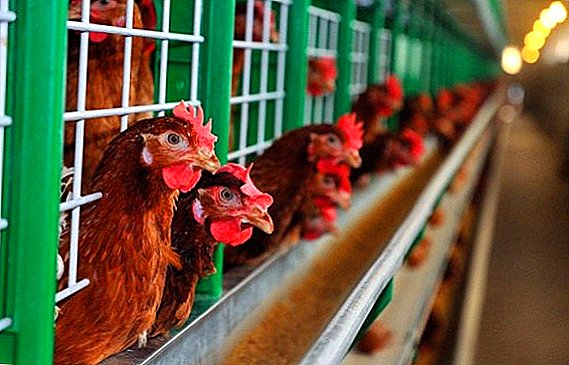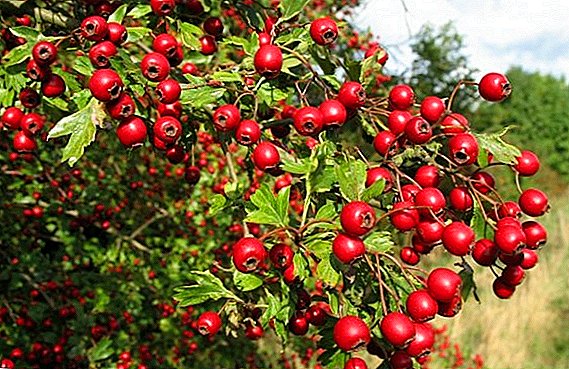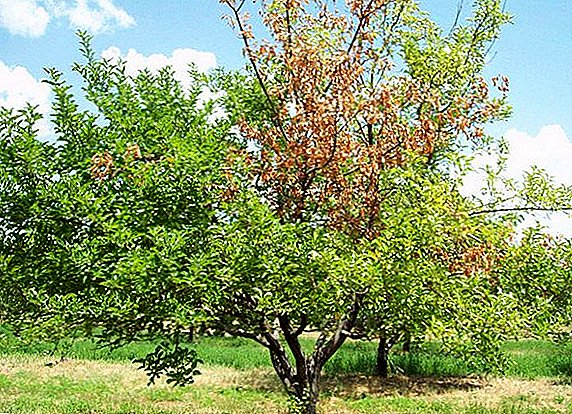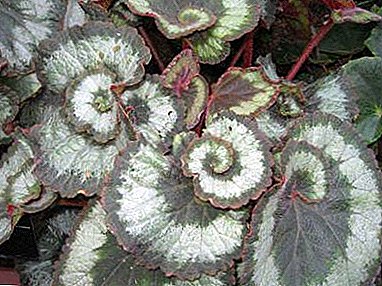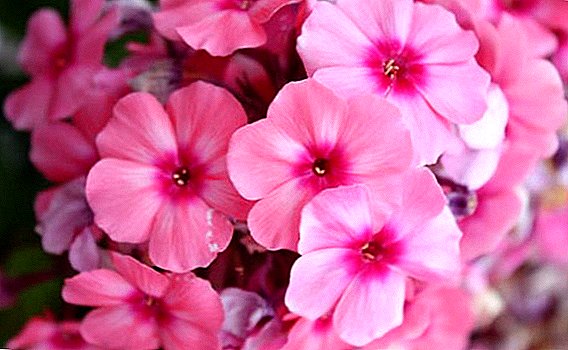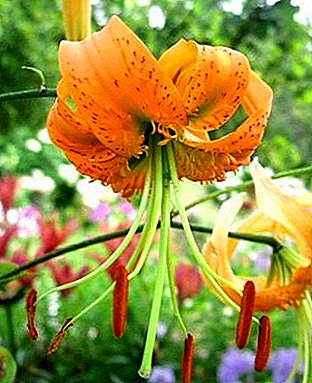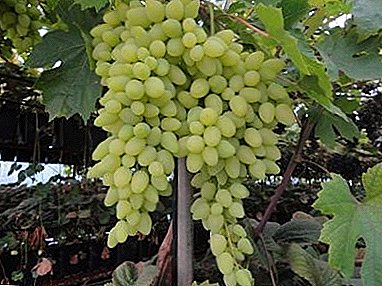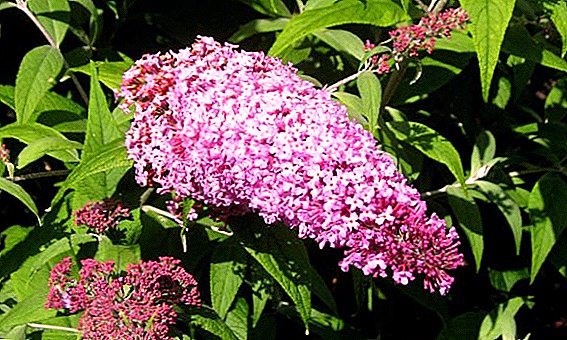 Budleja or buddleya (from Latin Buddleja) - it is a flowering deciduous or semi-evergreen shrub (there are also herbaceous plants) from the family Nornichnikovyh.
Budleja or buddleya (from Latin Buddleja) - it is a flowering deciduous or semi-evergreen shrub (there are also herbaceous plants) from the family Nornichnikovyh.
Did you know? Budley is named after the English botanist A. Baddle. It is also called the autumn lilac (inflorescences of budley resemble clusters of lilacs), a magnet for butterflies and a moth tree (pollinated by butterflies attracted by the scent of its flowers).Under natural conditions, it grows in warm and temperate zones of America, Asia, and South Africa. Budley has about 100 species. Next, we consider those that are most often found in decorative plantings.
Budley David
 The most popular among gardeners is the view of David’s budley, also called mutable. Comes from central and western China. This species is well adapted to our climate. As a shrub - grows up to 2-3 meters, as a tree with lowered ends of spreading branches - up to 5 m. The shoots are flexible and long. The leaves are large (up to 25 cm long), dark green on the outside and light yellow, pubescent - on the inside. They are lanceolate or oval-lanceolate with a pointed tip.
The most popular among gardeners is the view of David’s budley, also called mutable. Comes from central and western China. This species is well adapted to our climate. As a shrub - grows up to 2-3 meters, as a tree with lowered ends of spreading branches - up to 5 m. The shoots are flexible and long. The leaves are large (up to 25 cm long), dark green on the outside and light yellow, pubescent - on the inside. They are lanceolate or oval-lanceolate with a pointed tip.
Small purple, sometimes pink, white, red flowers (1.5 cm in diameter), usually with an orange core, collected in elongated (40 cm) spike-like dense inflorescences. Budylaya David blooms for 1.5 months from mid-summer until October. Varieties of the species can be divided into 3 groups:
- White flowers (White Cloud, White Profession, Alba).
- With purple flowers, including all sorts of shades of color (Black Knight, Empire Blue).
- Have flowers of red shades (Harlequin, Royal Red).
Important! For growth, you need a sufficient amount of light, regular watering and irrigation, limestone, periodic top dressing, insulation in winter.
Budley Wich
Budley Wicha is a derivative of Budley David and has similar characteristics. But this form is larger, it is famous for its dimensions. This voluminous and tall plant blooms from the beginning of August. The inflorescences are large, cone-shaped, bright saturated color.
Budley Wilson
 Also a derivative of David's budley. It is a tall bush with a special structure of branches having an arched shape. Inflorescences reach 75 cm in length and have a bright pink-lilac color. It is characterized by late flowering.
Also a derivative of David's budley. It is a tall bush with a special structure of branches having an arched shape. Inflorescences reach 75 cm in length and have a bright pink-lilac color. It is characterized by late flowering.
Budlea Beautiful
Budlaya the Beautiful is another form of budley David. Blooms large, dense, dense, air inflorescences in the middle of August. The flowers are deep pink and purple.
Important!Budley is a frost-resistant plant, some varieties of which can withstand temperatures up to -20 С. The above-ground part will freeze out, but in the spring new shoots will grow from the roots, and the bush will blossom in the same year.
Belotsvetkovaya Budley
 This is a beautiful shrub with small lilac, light mauve or white flowers, gathered in narrow cylindrical or conical inflorescences up to 45 cm in length. Abundant and long flowering occurs in June. Perfect for ornamental gardening, but is extremely rare. White-flowered Budley grows up to 6 m in height. Has upright thick crown.
This is a beautiful shrub with small lilac, light mauve or white flowers, gathered in narrow cylindrical or conical inflorescences up to 45 cm in length. Abundant and long flowering occurs in June. Perfect for ornamental gardening, but is extremely rare. White-flowered Budley grows up to 6 m in height. Has upright thick crown.
Young shoots pubescent along the entire length, with time they become smooth. The leaves are opposite, lanceolate, broad, with sharp ends and a dentate edge. Length up to 30 cm. They are dark green and smooth on the outside and silvery with pubescence on the inside. The plant is characterized by medium frost resistance and unpretentiousness in care.
Did you know?Today, budley extract is used in medicine as a natural pain reliever and antipyretic agent. It also has SPF properties and is therefore used to combat skin aging. And the leaves and flowers contain saponin (cleansing agent) and can be used as a substitute for soap.
Regular leafy
 The next leafy budley is almost a primeval variety of budley, originally from the northern and western regions of China. This is a deciduous shrub, reaching 4 m in height. Very resistant to heat and drought. The shoots are graceful, long, thin, arched. Old branches of gray color with exfoliating bark, young - brown, with a smooth surface. The leaves are wide or narrow, lanceolate, up to 6 cm long with a sharp end. To the base narrowed. The upper side is dim, dark green, the bottom is gray in color (due to star pubescence).
The next leafy budley is almost a primeval variety of budley, originally from the northern and western regions of China. This is a deciduous shrub, reaching 4 m in height. Very resistant to heat and drought. The shoots are graceful, long, thin, arched. Old branches of gray color with exfoliating bark, young - brown, with a smooth surface. The leaves are wide or narrow, lanceolate, up to 6 cm long with a sharp end. To the base narrowed. The upper side is dim, dark green, the bottom is gray in color (due to star pubescence).
Small flowers with almond aroma are collected in hanging medium-sized inflorescences of pinkish-lilac or lilac color. The flowering period lasts 20-25 days. The plant grows quickly, unpretentious to the soil, but very light-requiring. A specific feature of the bred turnifolia is that generative buds do not form on young shoots, unlike other species of the genus.
Snow Budley
 This beautiful deciduous shrub is not widely spread in our latitudes. Reaches 3-meter height. Shoots heavily pubescent, falling. Foliage and flowers also have abundant pubescence, similar to felt. The plant seems to be powdered with snow. Small fragrant flowers form small (10-15 cm) inflorescences-panicles of various lilac shades. Inflorescences are located at the ends of the shoots in several pieces. This species does not differ in frost resistance, it is thermophilic, but it is not capricious in care and is resistant to diseases.
This beautiful deciduous shrub is not widely spread in our latitudes. Reaches 3-meter height. Shoots heavily pubescent, falling. Foliage and flowers also have abundant pubescence, similar to felt. The plant seems to be powdered with snow. Small fragrant flowers form small (10-15 cm) inflorescences-panicles of various lilac shades. Inflorescences are located at the ends of the shoots in several pieces. This species does not differ in frost resistance, it is thermophilic, but it is not capricious in care and is resistant to diseases.
Japanese Budley
 Budley Japanese in Europe cultivated since 1866. The plant is a fast-growing deciduous shrub with a height of 2-3 m. Tetrahedral shoots form a sprawling crown.
Budley Japanese in Europe cultivated since 1866. The plant is a fast-growing deciduous shrub with a height of 2-3 m. Tetrahedral shoots form a sprawling crown.
The leaves are located opposite. They are wide, lanceolate, pointed, 10-12 cm in length. There are finely toothed and large teeth. From above naked, and from below in the beginning felt, and then also naked. At the end of the shoots are drooping 20 cm buds composed of pale lilac flowers with a fragrant scent. Surpasses other types of growth rates, but less decorative.
Globular budleya
 This species was discovered back in 1782. A semi-evergreen or evergreen shrub with spreading shoots that grows in the western regions of Argentina and Chile. Can grow up to 5-6 m in height. The foliage is lanceolate or elliptical, smooth on the outside, and pubescent on the inside. The length of the sheet is about 15 cm.
This species was discovered back in 1782. A semi-evergreen or evergreen shrub with spreading shoots that grows in the western regions of Argentina and Chile. Can grow up to 5-6 m in height. The foliage is lanceolate or elliptical, smooth on the outside, and pubescent on the inside. The length of the sheet is about 15 cm.
It blooms in May with small orange or bright yellow flowers, collected in spherical inflorescences and located at the ends of the shoots. It produces a sweet, honeyed aroma to attract insects. Fruit ripening occurs in September. Extremely thermophilic, therefore cultivation is possible only in the southern regions.
This article has described some popular types of such a beautiful ornamental plant as a budley. Each has its own characteristics, advantages and disadvantages. When making a choice, consider the characteristics of the species, and this shrub will constantly delight you with its flowering.



